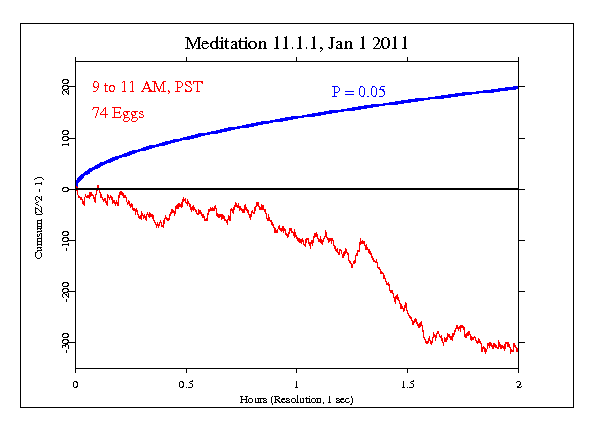|
Anuradha Choudry wrote 13th Jan (India time) about the
Ekataa programme, which sponsored and organized
a large meditation event November 11 2010, and now has done
two more. One was on January 1st 2011, and a second was on
the 11th. I was asked to look at the GCP data, to see if
there might be any indication of changes correlated with the
meditation. It is not appropriate to include the event in
the formal series, but it can be analysed using the same
procedures, including a priori specification.
Anuradha's message did not have specific time information, but another,
independent query did. I received the second inquiry on Jan
12, from someone who had noted a persistent deviation in the
GCP data:
I am wondering if the following event is
related:
http://www.worldpuja.org/1-1-11.php
Could you please check how the gcp data correlates with this event?
It took place on January 1st 2011 between 9 and 11 am (PST).
In a recent mailing (Jan.2011) from Worldpuja, it is stated:
"The World Puja Broadcasting Network: the Leader in
Empowerment Internet Radio," is now in its 11th year of daily global
broadcasting. More than 900,000 people have made their way to The World
Puja Network's daily, powerful, compelling informative
broadcasts, over 1,100 timeless, empowering archives and multi-faceted
website."
From that, it is reasonable to infer that a significantly large group
of humans were focused at the time of this "World Meditation
& Planetary Transmission".
Thank you & greetings from Switzerland!
Marc Golta
Though this was an informal exploration, the results are
worth giving in detail, even though they cannot be included
in the formal event tally. The prediction was a
priori, derived from the emails asking about it and
providing the exact timing of the event. The result is
6884.638 on 7200 df, for p = 0.996, and Z = -2.662.
The graph shows a steady trend over the two hours,
indicating persistent low network variance.

It is important to keep in mind that we have only a tiny
statistical
effect, so that it is always hard to distinguish signal from
noise. This means that every "success" might be largely
driven by chance, and every "null" might include a real
signal overwhelmed by noise. In the long run, a real effect
can
be identified only by patiently accumulating replications of
similar analyses.
|